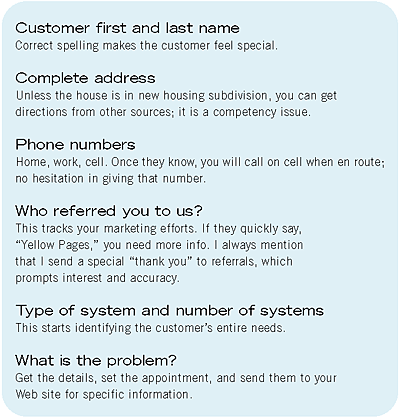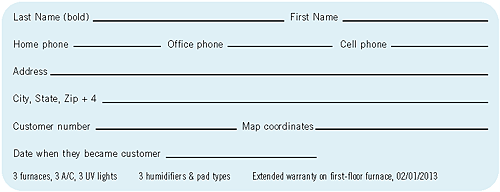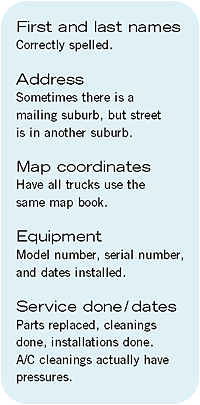Getting a new residential customer who actually appreciates your work and pays promptly for that work should be cherished. And, I deliberately use the word cherished. You worked hard and sometimes paid a great deal for that new customer.
You never want to willingly lose a customer. So, from the very beginning, everything must be done properly to retain the relationship. Sometimes, continuing that relationship means maintaining communications while the customer moves from one location to another and then to another location. As long as the customer is in your territory, you want that customer. And, if the customer leaves for another city, then returns, you want that customer back. And, don't forget the potential new customers from the existing address.
Accurate Data Needed
The first time a potential customer calls, make sure you get all the correct pertinent information. The customer will be impressed that you care enough to get it right. It sets the stage for reinforcing your company's beliefs. After all, it's best to do everything right the first time.The accurate data also gives you the much-needed information of growth, lack of growth, and effectiveness of marketing. Once you start compiling the information in useful programs, you can start to predict future growth, plan budgets, and spot weaknesses. And, you never forget when customers' warranties expire or other potential cash losses. (See Figure 1 for an example work sheet.)

Immediately get the zip code+4 for all mailings and confirm address data. Put this in your residential mailing list. If you have both commercial and residential customers, there should be two separate mailing lists. The residential list asks for first names and then last names, addresses, city, state, and zip code+4. Do not use the old fashioned and impersonal "Mr. & Mrs." First names show the customer you do know who they are.
Keeping track of divorces and deaths is sometimes difficult, but it helps ease the pain of the event. Make a rule that either male or female is "first" because sometimes the first name does not indicate gender. Be consistent on the mail list, database, and all other company information sheets.
After the appointment and the customer has a completed service invoice, start processing the new customer. Using a custom stamp right on the invoice makes sure every step is complete. (The stamp can be small, but should contain the information included in Figure 2.)

In regard to the newsletter, always send your current one with a promo item (magnet, pen, business card) to the new customer. In regard to the file folder, keep a file on each customer with all invoices and completed proposals.
Finally, each desk in the office should have a rotary file with all customers. You don't want to have the customer wait until the computer warms up, or you finally get to the data program, or, worse yet, you go and try to find the file. If there are specific questions, then get the file to discuss the facts. (See Figure 3 for information to include on the rotary card.)

Using colored transparent card protectors, use the following suggested coding for the rotary cards:
The Important Invoice
Invoices should be letter size and contain spaces for both billing and job addresses. Information on the invoice should include customer number, current phone numbers, equipment being worked on, model number, serial number, filter sizes, tech name, outside temperatures and conditions (snowing, windy, sunny), problem, work done, parts used, and recommendations.Three-part invoices are helpful. Top copy stays with the customer. The second and third copies go to the office. The tech should write any additional information on these copies that would be helpful or when further explanation is needed. The second copy should eventually be placed in the customer's file. The third copy is for inventory and filed separately. (In truth, this is the emergency copy for when the second copy is nowhere to be found.)
Once the invoice comes to the office, it is stamped with a small custom stamp. (See Figure 4 for an example.) As each portion is done, the person doing it initials that task. So, a quick glance tells if the invoice can be filed. Highlighting any recommendations makes sure that the invoice is further processed for additional work.


Data No. 1 is actually the database program. The second is a basic personal checking account program. Each year gets a new "account" of receivables.
All that is entered is the date, last name, (and first, if duplicates), invoice number, type of service (residential heat service or residential heat install) and the amount, just as you would enter a single deposit or check. This program gives you an immediate total of sales sold for the year. Again, a monthly reconciliation of the two programs ensures accuracy. Invoices are entered regardless of payment made or outstanding.
It's All About The Data
Your database should contain the information addressed in Figure 5. This information is printed out at least quarterly for the service trucks. Yes, for the service trucks. A small company needs the accuracy of a good database at the techs' fingertips. It stops arguments of how new is that furnace, when or if it was ever cleaned, or when the warranty expires. Too often those questions occur when no one is in the office to look up the file.Buying expensive data and/or dispatching systems must be carefully justified. Talk to your accountant and see if a new computer and database program will be cost effective.
Next installment: Saying thanks can bring in great referrals.
Publication date: 06/14/2004

Report Abusive Comment